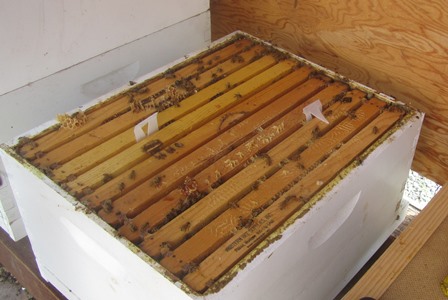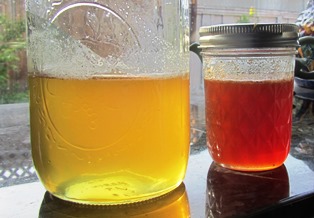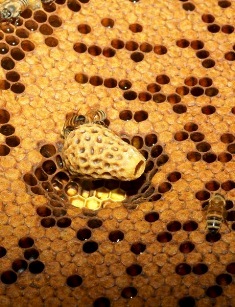Preparing Honeybee Hives for Spring
Recently, I conducted a mid-winter check of my honeybee hives. With my beekeeper neighbor’s help, we opened my Henny Penny Farmette Hives A and B to search for signs of an increase in the mite population, the presence of other pests, and evidence of mold. Inspecting and treating bees with medicines when necessary are important bee management practices.
We found one bug that I couldn’t identify but my neighbor explained it lays a narrow worm and must be removed before its numbers increase. This we did. We also found three frames in Hive B that had a few spots of mold. We threw away the frames and replaced them with wax-covered frames in the lower hive box where the queen had already produced lots of bee babies.
There appeared to be adequate stores of honey, baby bee food, and lots of baby bees. In fact, we removed a few frames of honey from both hives. In their place, we inserted frames that previously had the honey drained off but wax left intact (these I always freeze before putting back into hives since freezing kills mites, larvae, and wax moth), making it easier for the bees to start building comb.
The honey I harvested is dark-colored and earthy tasting, typical of autumn honey when the bees collect pollen from eucalyptus, star thistle, and other sources available in autumn. In contrast, spring honey is light-colored and slightly citrus tasting from pollen gathered from blooming citrus trees and wildflowers.

Hang medicated miticide strips between frames inward from the edge of the hive box for mite control.
Since we found evidence of mites, we hung miticide strips between frames to combat tracheal and Varroa mites. Also, we sprinkled powdered sugar medicine (Tetra-Bee Mix 2X Medicated) over the frames to control risk of American foulbrood. Treating the hives thus will enable the bees to remain robust. I expect their numbers to swell with warmer weather which, in turn, translates to new swarms in the spring.
*Apivar is an effective treatment of Varroa mites. One strip per four to five frames works through contact and should be placed in high bee activity areas. Not to be used when honey supers (top hive boxes with frames of honey) are on.
*Tetra-Bee Mix 2 X Medicated is recommended for control of American foulbrood caused by paenibacillus larvae and European foulbrood caused by streptococcus pluton susceptible to oxytetracycline in bees when used as directed.
For more beekeeping tips, delicious recipes, and a wholesome whodunnit, check out my Henny Penny Farmette cozy mysteries: A BEELINE TO MURDER (paperback release in October 2016), MURDER OF A QUEEN BEE (hardcover October 2016), and HIVE OF HOMICIDES (October 2017). Find them on Amazon.com, Barnesandnoble.com and other online and conventional bookstores everywhere.
Why Use a Screened Bottom Board in the Hive?
When beekeepers see signs that the population of Varroa destructor mites are increasing in the hive, they will take action to reduce the mite population. One way they can track mite levels is by using a screened bottom board.
A close monitoring of a screened bottom board can give a beekeeper a good idea of whether or not the mite population is increasing or decreasing in the hive.
Mites fall through the screen to the ground. A screened bottom board stretches across a platform that the hive box sits on.
When the mites in a hive fall on solid bottoms in a hive box, they can ride back up into the interior of the hive on other bees. A great article for building your own screened bottom board can be found at http://www.michiganbees.org/wp-content/uploads/2012/03/Screened-Bottom-Board_20110324.pdf
The use of a screened bottom board prevents bees returning upwards in the hive. One sign of mites at work in a hive are wings missing from newly emerged baby bees. There are other signs as well.
For lots of interesting bee “stuff” as well as farming tips and delicious recipes, check out my newest novel, A BEELINE TO MURDER.
Now available online and from brick-and-mortar bookstores everywhere. See, http://tinyurl.com/p8d6owd
Honeybee Disorders and Diseases
The beleaguered honeybee is threatened from environmental stresses, pests, and diseases that not only can decimate the bees but continually challenge modern beekeepers who must figure out how best to treat the problems.
Beekeepers against the use of chemicals within the hive believe there are other options available for dealing with these challenges such as breeding stronger, more resistant bees. That can take years. Meanwhile, it is important to understand some of the problems that can assail a hive.
Chalkbrood
When you see a frame within the hive containing larvae that have turned chalky white, consider that you are likely dealing with chalkbrood. Infection is by a fungus, Ascosphaera apis, causing the larva to die after its cell has been capped. Only the larvae are susceptible. Healthy hives of bees can usually clean up the problem on their own. Re-queening the hive and rotating out the old comb comprise the best course of treatment.
Nosema
Nosema cerrane is a fungus infection of the adult bee, affecting the intestinal tract that results in diarrhea. The disease can weaken the bees and diminish the health of a hive. Heathy hives can usually fend off and recover from Nosema, but hives that are already week are more susceptible to Nosema infection.
Tracheal Mites
Tracheal mites infect the trachea (windpipe) of honeybees. Look for extended wings (when infected, bees are not able to fold their wings against their abdomens); missing wings, and dead bees on the ground outside of the hive.
Treatment consists of placing menthol crystals in the hive and leaving them for 14 days when temperatures at at 60 to 80 degrees Fahrenheit. The bees breathe in the menthol and mites die. Honey from medicated hives should not be consumed; frames for honey (for human consumption) can be put into the hive three to four weeks after medication is removed.
Alternatively, some beekeepers advocate using solid vegetable shortening and sugar patties, believing the bees eat the sugar and the shortening gets on their bodies making it difficult for mites to reproduce or attach to bees. A commercially available product Apiguard is also effective but must be used as directed. Do not treat when honey flow is on.
Most articles about treating bees with medications also warn that such treatments will contaminate the honey for human consumption and suggest treating bee colonies during certain times of the year, not treating during honey flows. Beekeepers are always advised to use medications according to instructions that come with them.
Varroa Mites
This external parasite of honeybees showed up in hives in the United States around 1980. Facing little resistance from American honeybees, it attacked adult and larvae, preferring drone (male) larvae to worker bee larvae. In addition to the mite’s direct attack on bees, it serves as a transmittor for viruses that can infect bees.
Treatment varies. One is to finely dust powdered sugar onto all the bees so the mite can no longer ling to the bees. Thus losing their grip, they fall off. Another treatment is to insert drone (male bee) comb. The mites prefer the drone larvae ( larger and develop over a longer period).
Once the mites infect the drone larvae, the drone comb is removed and put into a freezer, killing the mites. After a period of freezing, unseal the comb, return to the hive, and healthy worker bees will clean it.
Bee genetics might prove to be effective in the long run for dealing with the dreaded varroa mite. In the Primorsky region of Russia, a strain of bees have been found to be more than twice as tolerant to the varroa mite as conventional bee stocks and also more resistance to the tracheal mite. So after a period of quarantine, these Russian bees are available for commercial purpose in the United States.
Beekeepers can also control populations of mites using miticidal strips. These are hung inside the hive and must be handled and disposed of as hazardous material. Unfortunately, the mites are developing increasing resistance to the chemicals in miticides.
Foulbrood
The spore-forming bacterium Bacillus larvae is the most dreaded perhaps of all bee brood diseases–American foulbrood. European foulbrood is another brood disease of such highly infectious nature as to require the burning of the hive.
In American foulbrood, the bacterium infects larvae up to three days old producing millions of spores. Some bees are more susceptible to this highly communicable disease than others.
Teramycin (oxytetracycline) is the only drug approved to treat American Foulbrood Disorder. Many beekeepers use this drug annually as a prophylactic treatment for their hives. Once a hive is infected, burning the infected hive or hives is the only solution to stop the spreading since the spores can remain viable in honey and the beekeeping equipment for decades.
Note: Recommended reading: Top-Bar Beekeeping, Organic Practices for Honeybee Health, by Les Crowder and Heather Harrel (Chelsea Green Publishing 2012) and Keeping Bees and Making Honey, by Alison Benjamin and Brian McCallum (David and Charles Publishing 2008). See also, http://www.ars.usda.gov/Services/docs.htm?docid=2882
 Facebook
Facebook Goodreads
Goodreads LinkedIn
LinkedIn Meera Lester
Meera Lester Twitter
Twitter












